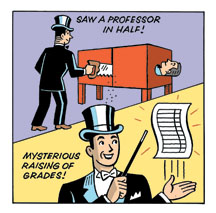
|
November 7, 2007: On the Campus
(Illustration: Ron Barrett; photos: Hyunseok Shim ’08) |
Feats of magic and card games
 By
Isia Jasiewicz ’10
By
Isia Jasiewicz ’10
Emily Sands ’09 was sitting in a booth at Chancellor Green Café one Friday afternoon when she noticed Randy Shine talking to two other students. She took off her headphones to listen, and the next thing she knew, Shine — a Philadelphia-based professional magician — had made a ball materialize in her closed hand. Looking up at him, she exclaimed, “That’s so beautiful!”
The three students were among dozens approached by Shine and another magician, Francis Menotti, as the two roved campus that day as part of the David A. Gardner ’69 Magic Project. Gardner paid his way through Princeton by doing magic tricks, and after his death in 2001, his widow, Lynn Shostack, established the fund to promote the academic study of magic on campus through grants for courses, research groups, and special events.
Carol Rigolot, executive director of the Council of the Humanities, said that the roving magicians were brought to campus at Shostack’s request to “cheer the students up.” Later that afternoon, Wilson College sponsored a magic workshop to give students an opportunity to learn about the trade. About 20 people showed up to watch as Shine made an egg appear in an empty bag and as Menotti conjured a turnip from thin air.
Shine and Menotti then gave students an opportunity to learn a few tricks of their own. Every student was given a deck of cards and a washer and taught basic card and coin tricks. The magicians also spoke about their experiences starting a magic club together at Penn State University.
Wilson Faculty Fellow Graham Jones, a lecturer in the Council of the Humanities, hopes students at Princeton will follow the magicians’ example and set up a club of their own. Magic, he said, is “a form of performance that is fun, accessible, and intellectually rich to boot.”
Yang Cai ’11, who took magic classes in Beijing before coming to Princeton, agreed. “Magic constantly challenges the magician’s imagination,” he said. “This feeling is unique, and I can’t find it through anything else.”
 By
Laura Fitzpatrick ’08
By
Laura Fitzpatrick ’08
On a sunny Sunday afternoon in October, math club members were hunched over tables in the drab third-floor lounge of Fine Hall, deep in concentration. They scrutinized grids of symbols and searched for patterns among a series of colored shapes. “Set!” cried one young man. That’s the name of the game at the afternoon’s tournament and, winning a point, he swept up a handful of playing cards.
Developed by geneticist Marsha Jean Falco from a coding system she used in her lab in Cambridge, England, Set is a playground for the right brain. Adam Hesterberg ’11, the math club’s lanky freshman officer and a future math concentrator, was dressed for the occasion in a “CANADA/USA MATHCAMP” T-shirt sprinkled with equations. For the layperson, the challenge is spotting a pattern of three cards — a set — in a group of 12. Sets are defined by a single rule: each of four individual variables (shape, color, number, and texture) must be the same on all three cards, or different on each card. Sounds simple — until you try it.
In the advanced division, the concentration was palpable. The four beginners plugged away competently, but the five veterans played at lightning speed. One player in an official Set T-shirt machine-gunned cards down on the table, slapping his palm down on a set a fraction of a second after he finished dealing. Occasionally someone pounced on a set with such force that the cards went skimming across the table. Sportsmanship was a common denominator: When two players slammed on sets that overlapped by one card, they split the score, two and a half each.
By popular demand, Hesterberg tabulated the scores in ternary form (base three); then he fed them into a scoring algorithm on his TI-83 Plus based on matrices and Eigen vectors. When the tallies came in, Hersterberg was top Setter among the vets. Rebecca Legett, a senior in the mechanical and aerospace engineering department, won first prize for the neophytes — her own Set deck.
Then, walking back to the table and flopping on the couches, the players
started up again. The intensity stayed high, but this time they were playing
for fun. ![]()

To read our exclusively online On the Campus column, click here.
